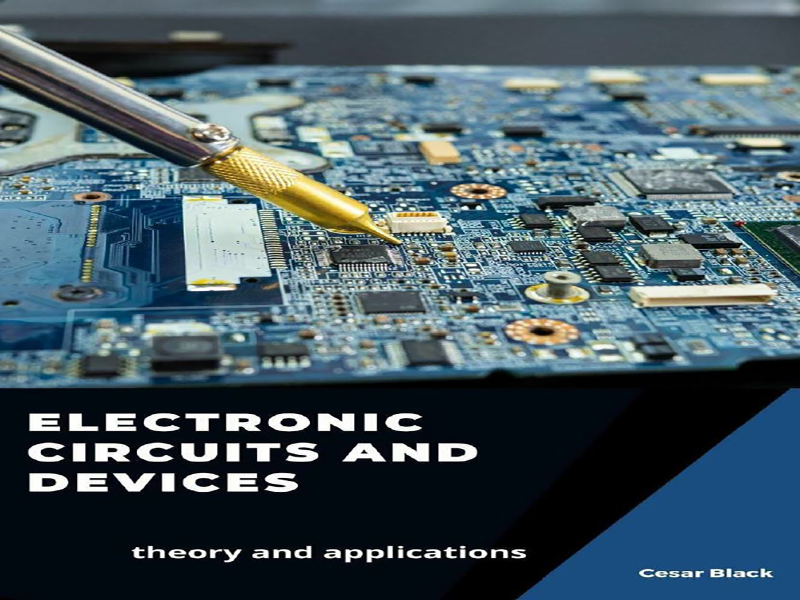- عنوان کتاب: Nanoelectronics -Materials to Chips Design
- نویسنده: Raj, BalwinderLata Tripathi, SumanChaudhary
- حوزه: طراحی تراشه
- سال انتشار: 2025
- تعداد صفحه: 434
- زبان اصلی: انگلیسی
- نوع فایل: pdf
- حجم فایل: 17.3 مگابایت
دستگاههای نانوالکترونیکی مانند ترانزیستورهای اثر میدانی دو گیتی فلز-اکسید-نیمهرسانا (MOSFET)، ترانزیستورهای اثر میدانی پرهدار (FinFET)، نانوسیمها، ترانزیستورهای اثر میدانی نانولوله کربنی (CNTFET)، ترانزیستورهای اثر میدانی تونلی (TFET)، ترانزیستورهای اثر میدانی فروالکتریک (FeFET)، FETهای گیت-همهجانبه (GAA)، ترانزیستورهای با تحرک الکترونی بالا (HEMT) و دستگاههای مبتنی بر اسپین، برای طراحی تراشه پیشنهاد و در مقالات موجود هستند. مطالعه این دستگاهها در بخشهایی که کاربردهای آنها در طراحی تراشه به دلیل بهبود خواص الکترونیکی دستگاههای نیمهرسانای نانومقیاس، تأثیر زیادی بر پیشرفتهای انقلابی در دستگاهها، مدارها و سیستمهای نانوالکترونیکی دارد، مهم است. در حال حاضر، دانش و منابع لازم برای ساخت این دستگاههای نانوالکترونیکی نیز موجود است، زیرا جریان ساخت آن مشابه MOSFET معمولی است. نقشه راه بینالمللی فناوری برای نیمهرساناها (ITRS) پیشبینی میکند که با پیشرفت فناوری، میتوان از جریان ساخت معمولی برای دستگاههای نانوالکترونیکی استفاده کرد. این کتاب روشی منحصر به فرد برای توضیح نانومواد، دستگاهها و تحلیل پارامترهای طراحی آنها برای برآورده کردن چالشهای زیر-نانو-رژیم برای طراحی تراشههای کممصرف ارائه میدهد. از آنجایی که تغییرپذیری فرآیند، اندازه دستگاه و مقیاسبندی منبع تغذیه از چالشهای مداوم در طراحی مدارهای مجتمعسازی در مقیاس بسیار بزرگ (VLSI) هستند، این کتاب نانومواد، دستگاهها و مدارهای مرسوم و جدید، تکنیکهای کاهش جریان نشتی و سایر بدهبستانهای مهم را همراه با تحلیل جامع برجسته میکند. در سراسر کتاب تمرکز بیشتری بر بدهبستانهای مختلف برای طراحی مشترک دستگاهها و مدارهای VLSI پرسرعت و کممصرف قرار گرفته است. فصل 1: این فصل بر طرحهای غیرمتعارف مانند MOSFET دابلگیت (DG)، MOSFET تریگیت، GAAFET و MOSFET دو-گیت احاطهکننده استوانهای (CSDG) تمرکز دارد و توسعه و چشمانداز معماریهای MOSFET بررسی میشود. این ساختارها برای سیستمهای ارتباطی آینده مناسب هستند، زیرا با نزدیکتر شدن دستگاهها به حوزه نانومقیاس، نقش مهمی در کاهش اثرات کانال کوتاه ایفا میکنند. ترانزیستور اثر میدانی (FET) که در سال ۱۹۳۰ در پاسخ به تقاضا برای دستگاههایی سریعتر، ارزانتر، کوچکتر و کممصرفتر توسعه داده شد، موضوع اصلی این فصل است. هنگامی که کاهنگ و آتالا FET با گیت عایقبندی شده را ساختند، پیشرفت مهمی حاصل شد که از ساختار فلز-اکسید-نیمهرسانا (MOS) برای حل مشکل حالتهای سطحی در رابط اکسید-نیمهرسانا استفاده میکرد. گسترش سریع نرخ دادههای بیسیم نیز در این فصل، همراه با نیاز روزافزون به فناوری که بتواند حجم عظیمی از دادهها را با مصرف انرژی کم مدیریت کند، پوشش داده شده است. این فصل با برجسته کردن اهمیت مقیاسبندی برای افزایش عملکرد سیستم با هزینه کمتر، درایو جریان، ظرفیت محاسباتی و چگالی ادغام به پایان میرسد. این فصل به اصول مقیاسبندی، اهمیت حفظ نسبت هندسی و مزایای مقیاسبندی، از جمله تأخیر کمتر، فرکانسهای ساعت بالاتر و مصرف انرژی کمتر، میپردازد. با اشاره به قانون مور و نقشه راه فناوری بینالمللی برای نیمهرساناها (ITRS)، این فصل با بحثی در مورد آینده مقیاسبندی به پایان میرسد. فصل 2: توسعه فناوری CMOS (مکمل فلز-اکسید-نیمهرسانا) با دستیابی به چگالی بالاتر، عملکرد بهبود یافته و مصرف توان کمتر هدایت میشود. با این حال، با پیشرفت به سمت مقیاسهای کوچکتر، چالشهایی به ویژه در مورد اثرات کانال کوتاه (SCE) هنگامی که طول کانال به عرض لایه تخلیه نزدیک میشود، پدیدار میشوند. در مقیاس نانو، MOSFET های مسطح با اثرات لبهای مواجه میشوند که برای رفع مشکلات، طول کانال طولانیتر را ضروری میسازد. این کشیدگی، کنترل گیت و راندمان توان را به خطر میاندازد و یک گلوگاه بحرانی را در مقیاسبندی سنتی CMOS برجسته میکند. برای غلبه بر این چالشها، معماریهای نوآورانهای مانند ترانزیستورهای اثر میدانی سیلیکون روی عایق (SOI) و فینفت (FinFET) ظهور کردهاند. این معماریها ظرفیت خازنی گیت به کانال بالاتر و ظرفیت خازنی درین به کانال پایینتری را ارائه میدهند که امکان کنترل بهتر جریانهای نشتی، به ویژه در مرکز کانال را فراهم میکند. اتخاذ ساختارهای چند گیتی، کنترل الکترواستاتیک بهبود یافته را تسهیل میکند و محدودیتهای ناشی از اثرات کانال کوتاه را کاهش میدهد. فصل ۳: این مطالعه با بررسی طیف وسیعی از گجتهای پیشرفته و فناوریهای پیشرفته، حوزه نانوالکترونیک را بررسی میکند. هدف اصلی، انجام تجزیه و تحلیل کامل عملکرد هر فناوری با مقایسه دقیق عوامل مهم است. این گفتگو جدیدترین پیشرفتها در قطعات الکترونیکی نانومقیاس را پوشش میدهد و ویژگیها و قابلیتهای خاص آنها را روشن میکند. این فصل در پی ارائه بینشهای مهم در مورد وضعیت فعلی نانوالکترونیک و زمینهسازی برای پیشرفتهای آینده در این بخش به سرعت در حال توسعه با تجزیه و تحلیل انتقادی این فناوریها است…
Nanoelectronic devices such as double-gate metal–oxide–semiconductor field-effect transistors (MOSFETs), fin field-effect transistors (FinFETs), nanowires, carbon nanotube field-effect transistors (CNTFETs), tunnel field-effect transistors (TFETs), ferroelectric field-effect transistors (FeFETs), gate-all-around (GAA) FETs, high-electron-mobility transistors (HEMTs), and spin-based devices are proposed and available in the literature for chip design. The study of these devices is important in sectors whose applications in chip design have a huge impact on bringing revolutionary advancements in nanoelectronic devices, circuits, and systems due to improved electronic properties of the nanoscale semiconductor devices. Currently, the knowledge and resources for the fabrication of these nanoelectronic devices are also available, as its fabrication flow is similar to conventional MOSFET. It is predicted by the International Technology Roadmap for Semiconductors (ITRS) that with the advancement of technology, the conventional fabrication flow can be used for nanoelectronic devices. This book exhibits a unique way to explain nanomaterials, devices, analyses of their design parameters to meet the sub-nano-regime challenges for low-power chip design. Since process variability, device sizing, and power supply scaling are ongoing challenges in very large-scale integration (VLSI) circuits design, this book highlights the conventional and novel nanomaterials, devices and circuits, leakage current mitigation techniques, and other important trade-offs along with exhaustive analysis. More focus has placed throughout the book on various trade-offs for high-speed and low-power VLSI devices and circuits co-design. Chapter 1: This chapter focuses on unconventional designs like doublegate (DG) MOSFET, tri-gate MOSFET, GAAFET, and the cylindrical surrounding double-gate (CSDG) MOSFET, and the development and prospects of MOSFET architectures are examined. These structures are suitable for upcoming communication systems, as they play a critical role in mitigating short-channel effects as devices get closer to the nanoscale domain. The field-effect transistor (FET), which was developed in 1930 in response to the demand for devices that were faster, cheaper, smaller, and less power-intensive, is the main topic of this chapter. An important breakthrough was made when Kahng and Attala created the insulated-gate FET, which used a metal–oxide–semiconductor (MOS) structure to solve the problem of surface states at the oxide–semiconductor interface. The fast expansion of wireless data rates is also covered in this chapter, along with the growing need for technology that can manage massive volumes of data while consuming little power. This chapter concludes by highlighting the significance of scaling for enhancing system performance at a lower cost, current drive, computational capacity, and integration density. It goes over the fundamentals of scaling, the significance of keeping the geometrical ratio, and the advantages of scaling, including lower latency, higher clock frequencies, and lower energy usage. With references to Moore’s law and the International Technology Roadmap for Semiconductors (ITRS), the chapter ends with a debate on the future of scaling. Chapter 2: CMOS (complementary metal–oxide–semiconductor) technology development is driven by the pursuit of higher density, improved performance, and lower power consumption. However, as advancements push toward smaller scales, challenges emerge, particularly regarding short-channel effects (SCEs) when channel lengths approach depletion-layer widths. At the nanoscale, planar MOSFETs encounter edge effects, necessitating longer channel lengths to address issues. This elongation compromises gate control and power efficiency, highlighting a critical bottleneck in traditional CMOS scaling. To overcome these challenges, innovative architectures like silicon-on-insulator (SOI) and fin field-effect transistors (FinFETs) have emerged. These architectures offer higher gate-to-channel capacitance and lower drain-to-channel capacitance, enabling better control over leakage currents, especially at the channel center. The adoption of multiple-gate structures facilitates enhanced electrostatic control, mitigating the limitations posed by short-channel effects. Chapter 3: This study explores the field of nanoelectronics by looking into a range of state-of-the-art gadgets and cutting-edge technology. The main objective is to conduct a thorough analysis of each technology’s performance by carefully contrasting important factors. The conversation covers the most recent developments in nanoscale electronic components and throws light on their special traits and capabilities. This chapter seeks to offer important insights into the current state of nanoelectronics and lay the groundwork for future advancements in this quickly developing sector by critically analyzing these technologies. We shall look into novel nanoelectric device structures in more detail later in this study, with particular emphasis on quantum dots, nanosheets, and tunneling devices. Examining these innovative architectures, this chapter provides a succinct but thorough examination of their special characteristics and uses. Chapter 4: High-electron-mobility transistors (HEMTs) have drawn a lot of attention lately because of their improved electron transport, which guarantees high-speed and high-power applications. With superior power density, outstanding high-frequency performance, and satisfactory manufacturing efficiency, HEMT devices are challenging and eventually replacing conventional field-effect transistors (FETs). An overview of the performance of certain well-known and often-used HEMT devices is given to readers in this study. This chapter begins with an overview of the various HEMT structures and then moves on to the working concept with graphical representations. The performance of the device is examined using both analytical and numerical models from the body of current literature. In addition, some noteworthy recent studies on HEMT devices have been pointed out, and future trends have been forecasted. An in-depth understanding of current findings, potential paths, and their analytical strategy would be helpful in creating innovative HEMT devices. Chapter 5: Metallic nanoparticles and their oxides have been the focus of extensive research due to their remarkable properties, prompting investigations for both fundamental understanding and practical applications. Various metallic nanoparticles and their oxides such as gold, silver, platinum, palladium, iron, copper, etc., have found numerous applications in a wide range of disciplines. The applications include nanotechnology, nanobiotechnology/nanobiomedicine, drug delivery, food/packaging industry, wound healing, cosmetics industry, animal husbandry, disinfection, environmental remediation, agriculture, and ceramics, to name a few. The synthesis of these nanoparticles can be achieved through physical, chemical, or biological means. While physical and chemical methods often involve toxic elements, time-consuming processes, and expensive instrumentation, biological synthesis, commonly referred to as green synthesis, offers a more environmentally friendly, costeffective, and non-toxic alternative. Utilizing plants and microorganisms, green synthesis showcases enhanced biocompatibility in the resulting nanoparticles. Within the realm of nanotechnology, phytonanotechnology emerges as a field leveraging plant-derived materials, notably harnessing bioactive compounds and phytochemicals, to advance innovative applications. Pomegranates contain numerous minerals, vitamins, and botanical compounds in their seeds, peels, and leaves, which offer various health benefits. Chapter 6: Memory blocks are part of many digital circuits and devices. Static random access memory (SRAM) and read-only memory (ROM) cells are frequently part of such memory. Prefabrication design and verification using EDA tools are becoming popular to avoid any failure after costly fabrication processes. This chapter provides description of basic memory design using the Tanner EDA tool. Here different technology nodes are compared for the design and simulation of SRAM and ROM blocks. Transient analysis is used for the evaluation of delay, noise margin, and power consumption. The presented work is useful in performance optimization at different transistor feature sizes and memory design topologies. Chapter 7: By stopping long-standby-time leakage energy, power-gating embedded memory is an effective way to achieve better power efficiency in generally off-instant-on applications. Presently available non-volatile SRAM (NVSRAM) architectures featuring in-cell NVM element backup provide a practical way to perform both normal-mode computation and offmode backup and restore (B and R). In order to achieve the optimal balance between B and R energy and area overheads, circuit enhancements are required. The field of system design is becoming more and more interested in emerging non-volatile memories. They are employed in the design of logic-in-memory circuits and in the proposition of von Neuman architecture substitutes. Logic-in-memory designs find special interest in ferroelectric memory technology based on hafnium oxide, which is entirely compatible with CMOS technologies. The ability to work with fine-grain logic in memory applications is made possible by this compatibility, as it allows for tight integration between the memory-capable element and the transistors in the system. Embedded artificial intelligence and non-volatile, energyefficient computing for the Internet of Things are two potential applications for this technology. Chapter 8: This comprehensive study investigates various aspects of sustainable bioplastic development and its implications. Firstly, the degradation of three bioplastics (poly(butylene succinate)-starch (PBSstarch), poly(butylene succinate) (PBS), and polylactic acid (PLA)) in soil environments was analyzed, revealing differential degradation rates correlated with the main components of bioplastics. The influence of bacterial biomass on bioplastic degradation was examined, indicating an enhanced degradation rate with increased bacterial biomass. Microbial diversity and nitrogen circulation in the soil remained unaffected by bioplastic degradation. Biodegradation tests on oil palm empty fruit bunch bioplastic composites showed higher rates than those of oxodegradable and conventional plastics. Sustainable bioplastic films made from Prosopis juliflora wood showed promising mechanical properties and biodegradability, making them viable alternatives to conventional plastics. Starch-based bioplastics were made from the starch of jackfruit seeds, and the mechanical characteristics of different plasticizers were investigated. Despite being weaker than polymers derived from petroleum, they are better for the environment. The study also looked into biodegradable polyvinyl alcohol-enhanced bioplastics made from maize starch and Euphorbia antiquorum latex. Chapter 9: The semiconductor industry underwent a revolution with the introduction of MOSFETs, which are now the foundation of many lowpower applications. Due to its high power consumption, MOSFET technology is becoming less and less common as it advances from the microscale to the nanoscale. Tunnel FET (TFET) has the benefit of eliminating the short-channel effects (SCEs) that affect MOSFETs. Because of its lower subthreshold swing (below 60 mV/dec), TFETs also require less power than MOSFETs. Extrinsic sources of variability are mostly likely variations that show up from one chip or wafer to the next and are brought on by strain and modifications to the architecture of the device. Wafer-towafer, wafer-level, die-level, layout-dependent, and other variations are caused by significant process variances in the production of integrated circuits. There are several factors that cause variability in the characteristics of FETs; some are discussed in this chapter such as random dopant fluctuation (RDF), orientation, and heavy-ion irradiation. Random dopant fluctuation (RDF), which is the doping variation or fluctuation resulting from the random occupancy of impurities in the device during manufacturing, is one of the major factors influencing the device’s variability among the other potential variations. The other factor is orientation; because of variations in recombination and generation rates, carrier tunneling mass, and tunneling barrier width, surface orientation affects the drain current of TFETs. Another is radiation, it is the major worry for semiconductor firms working on space devices. Radiation causes soft faults in the devices, which affects the integrated circuits’ dependability and creates variations in the properties of the devices. Chapter 10: This chapter introduces a novel 5-port MIMO antenna tailored for the 24–40 GHz frequency range, with a focus on applications such as n257, n258 satellite-to-ground communication, and n259, n260 NR 5G with material-based analysis. Fr4 and Roger substrate are used to analyze the approaches for the proposed antenna, and the Roger substrate is suitable for desirable outcomes. The antenna design is inspired by congruent circular rings incorporating fractal elements, resulting in a compact size and peak gain enhancement of 7 dBi, utilizing a Roger substrate with a height of 1.6 mm and dimensions of 25 × 25 mm2. The proposed MIMO configuration exhibits remarkable performance metrics, featuring an envelope correlation coefficient (ECC) below 0.012, a diversity gain surpassing 9.666 dB, and improved isolation among its ports. In terms of frequency coverage, the MIMO antenna spans a wide bandwidth, encompassing 5.5 GHz for port 1, 3.4, 4.2 GHz for port 2, 3.4, 4.2 GHz for port 3, 3.4, 4.2 GHz for port 4, and 3.4, 5 GHz for port 5 within the 24–40 GHz spectrum. This broad coverage ensures robust communication capabilities, aligning with the requirements of advanced 5G applications and satellite communication. Chapter 11: Two-dimensional (2D) nanomaterials are gaining a lot of attention these days in the field of electronics. 2D nanomaterials can be utilized to improve the performance of electromagnetic radiators (antennas). They offer advantages in antennas due to their lightweight nature, high electrical conductivity, tunable properties, broad bandwidth, and flexibility for conformal integration. This chapter aims to show how 2D nanomaterials like graphene can be utilized in improving the performance of antennas operating in the terahertz (THz) frequency range. Four antenna configurations, namely Antenna-A, Antenna-B, Antenna-C, and Antenna-D are presented in this work. It has been shown in this work that the use of graphene film significantly improves the performance of Antenna-B compared to Antenna-A. As the antenna is to be mounted on a silicon chip, a graphene layer is used in the ground plane for better heat transfer in Antenna-C. To further improve airflow and thermal convection, a hole/airway has been created in Antenna-D. Thus, it can help prevent overheating and performance degradation of other electronic components placed on a silicon chip. The electromagnetic and thermal behavior of Antenna-D mounted on a silicon chip is also shown in this chapter. Chapter 12: This review study presents a thorough examination of the properties and applications of nanomaterials in semiconductor devices. Specifically, we delve into the characteristics of nanowires, carbon nanotube field-effect transistors (CNTFETs), quantum dots, and other nanoscale materials. Our discussion encompasses a diverse range of applications across semiconductor devices, including GAAFETs (gate allaround field-effect transistors), MOSFETs (metal–oxide–semiconductor field-effect transistors), photovoltaic cells, nanowire array solar cells, quantum dot lasers, solar cells, and LEDs (light-emitting diodes). The exploration of nanowires elucidates their unique structural and electrical properties, emphasizing their pivotal role in enhancing transistor performance. Carbon nanotube field-effect transistors are scrutinized for their exceptional electrical conductivity and potential to overcome traditional transistor limitations. Quantum dots, with their quantum confinement effects, are discussed in detail for their applications in novel devices such as quantum dot lasers. This chapter provides a comprehensive overview of how these nanomaterials are strategically incorporated into semiconductor devices. GAAFETs and MOSFETs benefit from the superior electronic properties of nanowires and CNTFETs, thereby enhancing device efficiency and scalability. Photovoltaic cells, nanowire array solar cells, and solar cells, in general, demonstrate improved performance through the integration of nanomaterials, capitalizing on their unique optoelectronic properties. Chapter 13: This chapter introduces an innovative MUX-Based CMOS 8-Bit Encoder device designed to boost the binary conversion speed of Flash analog-to-digital converters (ADCs) specifically tailored for highspeed 5G communication systems and ultra-wideband (UWB) applications. The proposed encoder device employs a novel combination of a Wallace tree structure and a binary search algorithm to overcome limitations associated with conventional encoding methods. Through comprehensive simulations conducted in a 180 nm CMOS technology, the presented design demonstrates exceptional performance metrics. The achieved results include a compact track with an area of 3161 μm2, a minimal delay of 0.4090 ns, a low power consumption of 23.32 μW, and an impressive figure of merit at 13.28 fJ. These outcomes signify a remarkable improvement in conversion speed and a substantial reduction in power consumption, illustrating the potential for optimizing ADC performance in critical communication systems and UWB applications. While traditional encoding methods, such as binary ROM-based encoders, offer simplicity in design, they often compromise on speed and power efficiency. The proposed MUX-Based CMOS 8-Bit Encoder stands out as a compelling solution, striking a balance between simplicity and efficiency. By incorporating a Wallace tree structure and a binary search algorithm, this design not only enhances the conversion speed but also mitigates the drawbacks associated with traditional encoding methods. The presented results underscore the potential of this encoder device to revolutionize ADC performance, making it a promising candidate for applications in high-speed 5G communication systems and UWB scenarios.
این کتاب را میتوانید از لینک زیر بصورت رایگان دانلود کنید:




































نظرات کاربران